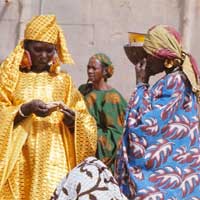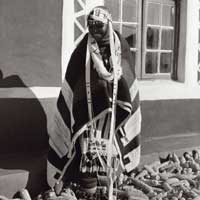

Fig. 1
Yoruba women dressed in their finest headties celebrating the Ogun festival

Fig. 2
Mangbetu women wearing backskirts performing circle dance

Fig. 3
Fulbe or Bozo women at market

Fig. 4
Ndebele woman wearing beaded blanket and accessories
TxtStyles/Fashioning Identity presents a selection of rarely exhibited textiles and apparel drawn from the museum's collection. Separate articles of clothing, such as women's skirts and blouses and men's tunics and pants, along with accessories like hats, wigs and jewelry, are appreciated in Africa for their beauty and the technical virtuosity in how they are made. In African contexts of use, however, these distinct elements of attire are just a part of something larger that carries stronger visual impact—namely, the ensemble, which conveys specific information in its entirety as well as through its components.
Traditional African clothing and adornment are extraordinarily beautiful and expertly made. Rich in content, they fashion identity and meaning through their forms, materials and presentation. The messages conveyed through these dynamic, ever-changing African art forms are similar to those articulated elsewhere in the world, emphasizing shared perspectives of the many ways that dress and the body are used for creative expression (fig. 1).
Appropriate attire is historically based and culturally defined
The world of African textiles is as rich and diverse as the African peoples themselves. Traditional clothing has ranged from the minimum required to fulfill norms of modesty—the attire of children, the beaded cache-sexe of adolescents, or the fiber backskirts of Mangbetu women (fig. 2)—to an elaborate layering of fabrics and accessories to communicate wealth, rank and prestige. There are practical considerations in one's choice of dress. A simple loincloth and hat may suffice when a man is working his fields or performing other arduous tasks in the hot sun. One's best outfits are much more complicated and reserved for special, public occasions, such as market days, celebrations and festivals (fig. 3). [The way clothing is tailored-formfitting or loose and flowing—affects how the body moves through space.
Clothing that is complex, multilayered and embellished with a wide array of components and materials often marks individuals of prominence or changes in status. The attire of traditional leaders, for example, is often quite elaborate, for it visually reinforces the social, economic and political power wielded by those in authority. An Ndebele woman may start her married life wearing a relatively plain front apron, but as she bears children and accumulates wealth and status through hard work and community service, her beaded attire becomes more elaborate and ornate as befitting her enhanced position in society (fig. 4).
At any age, an individual's appropriate dress and respectful demeanor suggest positive social values associated with the human ideal. In Africa, a beautifully made textile, hat or necklace, for example, may be perceived as culturally "good" and embodying desirable attributes associated with both maker and user. It reflects the expertise of the artist, whose work demonstrates training, skill and individual creativity as well as recognition of culturally defined aesthetic concepts that communicate meaning through form, material and contexts of use. It also acknowledges the personal taste and aesthetic refinement of the individual who commissioned or purchased the item and whose social standing is reaffirmed when it is worn or displayed.
Back to: NMAfA exhibits